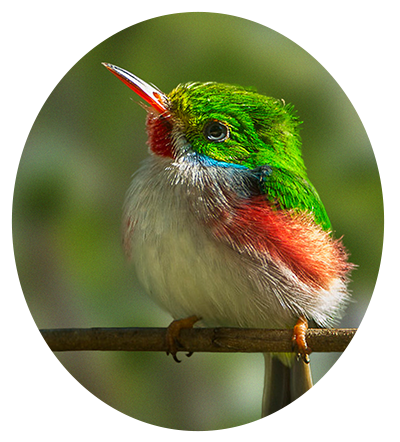

SCIENTIFIC NAME: Todus multicolor


The Cuban Tody is a bird species in the family Todidae.

It has a small body and relatively large head with broad, flat bill. It measures about 3.94 - 4.33 inches long and weighs about 4.3 - 8.5 grams.
Similar to other todies, its coloration includes iridescent green dorsum, pale whitish-gray underparts, and red highlights.
It is distinguished by its pink flanks, red throat, yellow lores, and blue ear patch. Bill is bicolored: black on top and red on the bottom. Eyes are pale gray-blue. Legs and feet are dull reddish.
Males and females are similar.
Juveniles are duller with a shorter bill, gray or pink throat, pale gray underparts and brown eyes. They lack the pink on flanks and the blue and yellow patches on the head.

Utters repeated notes “tot-tot-tot-tot” when perched. Typical call is a soft, clear, almost musical whistle “pprreeee- pprreeee”. In flight, its wings produce a mechanical noise.

Feeds primarily on caterpillars, spiders and insects (adults and larvae). It may occasionally take small lizards, and it feeds rarely on small fruits.

Frequents a variety of habitats, but it favors shaded areas close to streams and rivers. However, it is ecologically adaptable to the environment, and it can be found in wet thickets or woodlands, deciduous or pine forests and secondary vegetation.
It also occurs on mountain slopes and in gullies. On Isle of Pines, it frequents the orchards.
The Cuban Tody is the only Todidae to inhabit shoreline habitats. It can be seen from sea-level up to 1974 meters of elevation in Pico Turquino.

Guatemala in the south as far north as the upper Gila River in Arizona and New Mexico.
Found as a vagrant in southeasternmost and western Texas.

Nests consist of a tunnel about 12 inches long in a clay embankment, with a terminal chamber, though sometimes they use a rotten trunk or tree cavity.
The walls of the tunnel and the egg chamber are covered with a thick glue-like substance mixed with grass, lichen, algae, small feathers and other materials.
3 - 4 eggs are laid and are incubated for about 3 weeks by both parents.

SOURCES:
http://www.oiseaux-birds.com
https://en.wikipedia.org
https://ebird.org